ENG 1110-01: Technology's Influence on Literacy Across Generations
VerifiedAdded on 2023/03/31
|5
|1578
|335
Essay
AI Summary
This essay examines the complex relationship between technology and literacy, questioning whether technological advancements have led to a decline in literacy rates across generations. It presents three objections to the idea that technology enhances literacy, arguing that critical thinking skills may have deteriorated despite visual aptitudes improving. The essay counters these objections by emphasizing the role of educators in guiding technology use and the importance of technological literacy for informed participation in society. It further explores how technology has transformed communication, writing, and learning, creating new literacy spaces and multimodal forms of knowledge. The essay concludes by highlighting the non-neutrality of technology, the need for careful selection and adaptation of technology in education, and the importance of fostering a love of reading to develop critical thinking skills. The document is available on Desklib, a platform offering a range of study tools and resources for students.
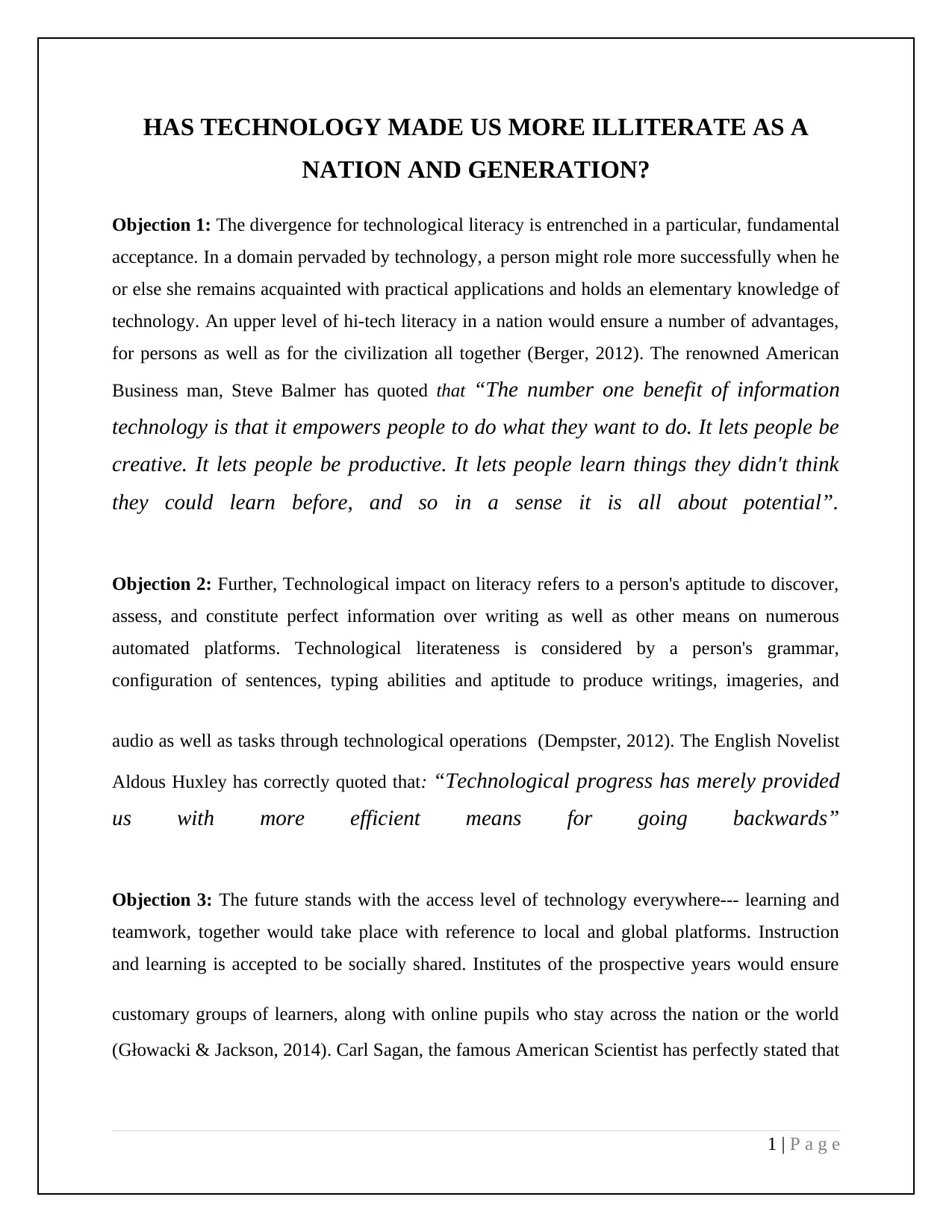
HAS TECHNOLOGY MADE US MORE ILLITERATE AS A
NATION AND GENERATION?
Objection 1: The divergence for technological literacy is entrenched in a particular, fundamental
acceptance. In a domain pervaded by technology, a person might role more successfully when he
or else she remains acquainted with practical applications and holds an elementary knowledge of
technology. An upper level of hi-tech literacy in a nation would ensure a number of advantages,
for persons as well as for the civilization all together (Berger, 2012). The renowned American
Business man, Steve Balmer has quoted that “The number one benefit of information
technology is that it empowers people to do what they want to do. It lets people be
creative. It lets people be productive. It lets people learn things they didn't think
they could learn before, and so in a sense it is all about potential”.
Objection 2: Further, Technological impact on literacy refers to a person's aptitude to discover,
assess, and constitute perfect information over writing as well as other means on numerous
automated platforms. Technological literateness is considered by a person's grammar,
configuration of sentences, typing abilities and aptitude to produce writings, imageries, and
audio as well as tasks through technological operations (Dempster, 2012). The English Novelist
Aldous Huxley has correctly quoted that: “Technological progress has merely provided
us with more efficient means for going backwards”
Objection 3: The future stands with the access level of technology everywhere--- learning and
teamwork, together would take place with reference to local and global platforms. Instruction
and learning is accepted to be socially shared. Institutes of the prospective years would ensure
customary groups of learners, along with online pupils who stay across the nation or the world
(Głowacki & Jackson, 2014). Carl Sagan, the famous American Scientist has perfectly stated that
1 | P a g e
NATION AND GENERATION?
Objection 1: The divergence for technological literacy is entrenched in a particular, fundamental
acceptance. In a domain pervaded by technology, a person might role more successfully when he
or else she remains acquainted with practical applications and holds an elementary knowledge of
technology. An upper level of hi-tech literacy in a nation would ensure a number of advantages,
for persons as well as for the civilization all together (Berger, 2012). The renowned American
Business man, Steve Balmer has quoted that “The number one benefit of information
technology is that it empowers people to do what they want to do. It lets people be
creative. It lets people be productive. It lets people learn things they didn't think
they could learn before, and so in a sense it is all about potential”.
Objection 2: Further, Technological impact on literacy refers to a person's aptitude to discover,
assess, and constitute perfect information over writing as well as other means on numerous
automated platforms. Technological literateness is considered by a person's grammar,
configuration of sentences, typing abilities and aptitude to produce writings, imageries, and
audio as well as tasks through technological operations (Dempster, 2012). The English Novelist
Aldous Huxley has correctly quoted that: “Technological progress has merely provided
us with more efficient means for going backwards”
Objection 3: The future stands with the access level of technology everywhere--- learning and
teamwork, together would take place with reference to local and global platforms. Instruction
and learning is accepted to be socially shared. Institutes of the prospective years would ensure
customary groups of learners, along with online pupils who stay across the nation or the world
(Głowacki & Jackson, 2014). Carl Sagan, the famous American Scientist has perfectly stated that
1 | P a g e
Paraphrase This Document
Need a fresh take? Get an instant paraphrase of this document with our AI Paraphraser
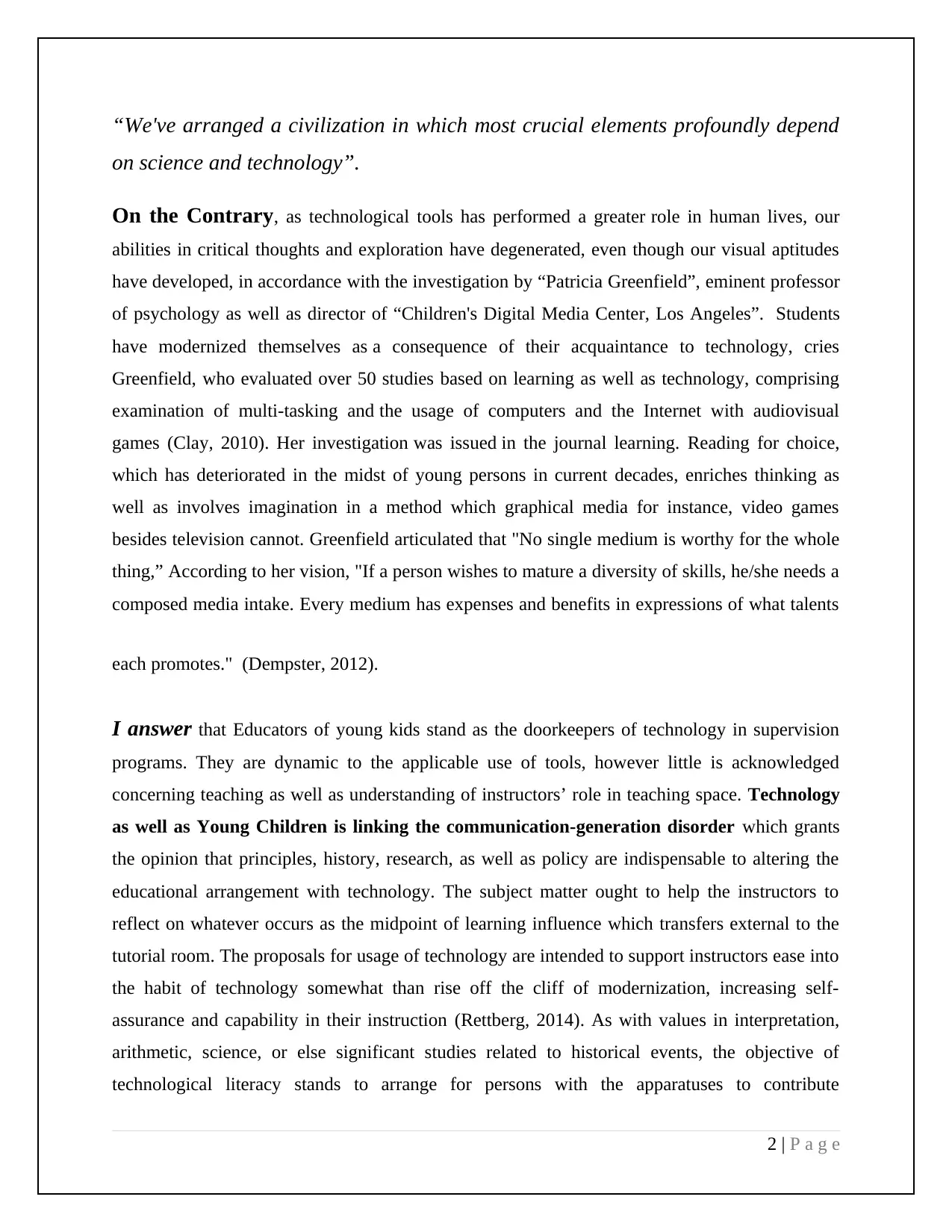
“We've arranged a civilization in which most crucial elements profoundly depend
on science and technology”.
On the Contrary, as technological tools has performed a greater role in human lives, our
abilities in critical thoughts and exploration have degenerated, even though our visual aptitudes
have developed, in accordance with the investigation by “Patricia Greenfield”, eminent professor
of psychology as well as director of “Children's Digital Media Center, Los Angeles”. Students
have modernized themselves as a consequence of their acquaintance to technology, cries
Greenfield, who evaluated over 50 studies based on learning as well as technology, comprising
examination of multi-tasking and the usage of computers and the Internet with audiovisual
games (Clay, 2010). Her investigation was issued in the journal learning. Reading for choice,
which has deteriorated in the midst of young persons in current decades, enriches thinking as
well as involves imagination in a method which graphical media for instance, video games
besides television cannot. Greenfield articulated that "No single medium is worthy for the whole
thing,” According to her vision, "If a person wishes to mature a diversity of skills, he/she needs a
composed media intake. Every medium has expenses and benefits in expressions of what talents
each promotes." (Dempster, 2012).
I answer that Educators of young kids stand as the doorkeepers of technology in supervision
programs. They are dynamic to the applicable use of tools, however little is acknowledged
concerning teaching as well as understanding of instructors’ role in teaching space. Technology
as well as Young Children is linking the communication-generation disorder which grants
the opinion that principles, history, research, as well as policy are indispensable to altering the
educational arrangement with technology. The subject matter ought to help the instructors to
reflect on whatever occurs as the midpoint of learning influence which transfers external to the
tutorial room. The proposals for usage of technology are intended to support instructors ease into
the habit of technology somewhat than rise off the cliff of modernization, increasing self-
assurance and capability in their instruction (Rettberg, 2014). As with values in interpretation,
arithmetic, science, or else significant studies related to historical events, the objective of
technological literacy stands to arrange for persons with the apparatuses to contribute
2 | P a g e
on science and technology”.
On the Contrary, as technological tools has performed a greater role in human lives, our
abilities in critical thoughts and exploration have degenerated, even though our visual aptitudes
have developed, in accordance with the investigation by “Patricia Greenfield”, eminent professor
of psychology as well as director of “Children's Digital Media Center, Los Angeles”. Students
have modernized themselves as a consequence of their acquaintance to technology, cries
Greenfield, who evaluated over 50 studies based on learning as well as technology, comprising
examination of multi-tasking and the usage of computers and the Internet with audiovisual
games (Clay, 2010). Her investigation was issued in the journal learning. Reading for choice,
which has deteriorated in the midst of young persons in current decades, enriches thinking as
well as involves imagination in a method which graphical media for instance, video games
besides television cannot. Greenfield articulated that "No single medium is worthy for the whole
thing,” According to her vision, "If a person wishes to mature a diversity of skills, he/she needs a
composed media intake. Every medium has expenses and benefits in expressions of what talents
each promotes." (Dempster, 2012).
I answer that Educators of young kids stand as the doorkeepers of technology in supervision
programs. They are dynamic to the applicable use of tools, however little is acknowledged
concerning teaching as well as understanding of instructors’ role in teaching space. Technology
as well as Young Children is linking the communication-generation disorder which grants
the opinion that principles, history, research, as well as policy are indispensable to altering the
educational arrangement with technology. The subject matter ought to help the instructors to
reflect on whatever occurs as the midpoint of learning influence which transfers external to the
tutorial room. The proposals for usage of technology are intended to support instructors ease into
the habit of technology somewhat than rise off the cliff of modernization, increasing self-
assurance and capability in their instruction (Rettberg, 2014). As with values in interpretation,
arithmetic, science, or else significant studies related to historical events, the objective of
technological literacy stands to arrange for persons with the apparatuses to contribute
2 | P a g e
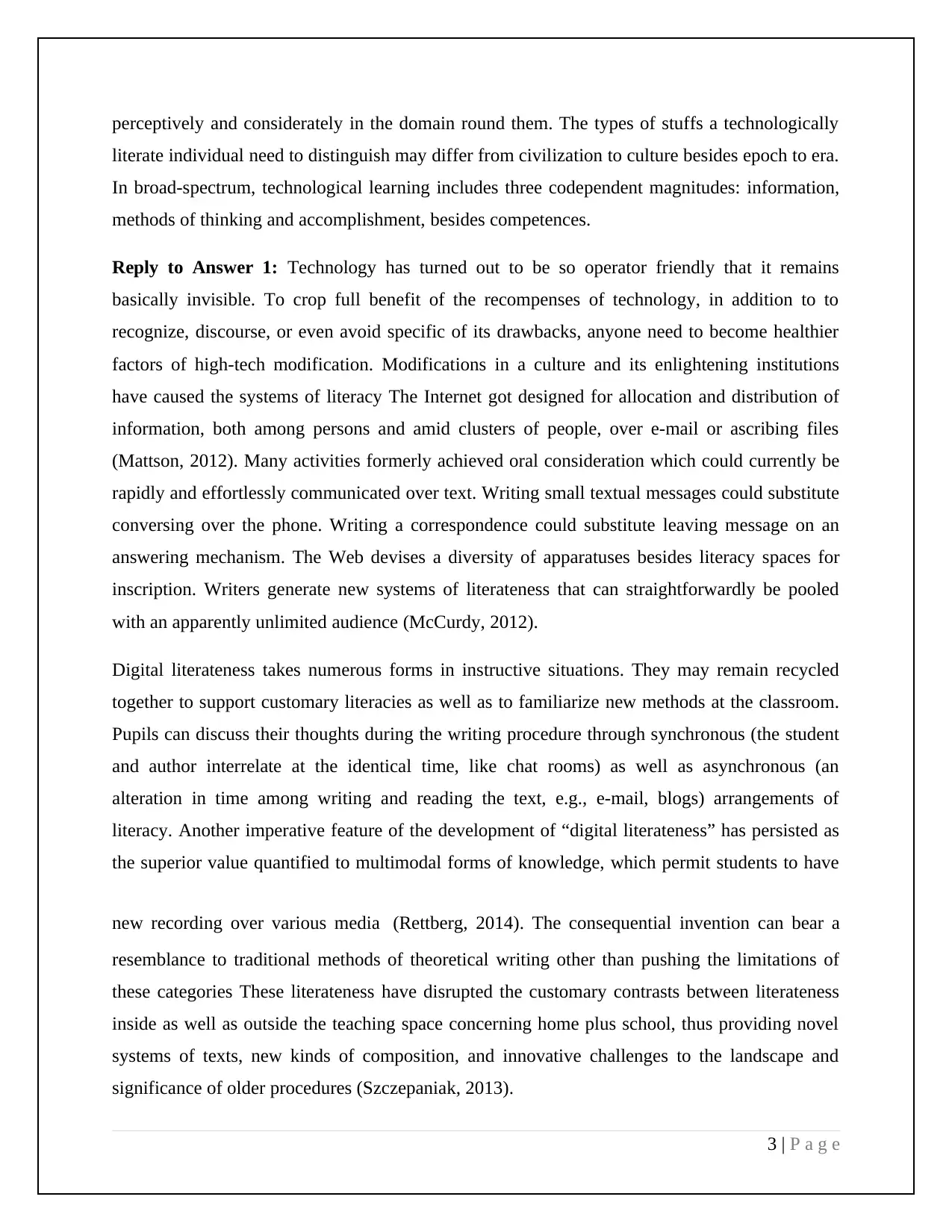
perceptively and considerately in the domain round them. The types of stuffs a technologically
literate individual need to distinguish may differ from civilization to culture besides epoch to era.
In broad-spectrum, technological learning includes three codependent magnitudes: information,
methods of thinking and accomplishment, besides competences.
Reply to Answer 1: Technology has turned out to be so operator friendly that it remains
basically invisible. To crop full benefit of the recompenses of technology, in addition to to
recognize, discourse, or even avoid specific of its drawbacks, anyone need to become healthier
factors of high-tech modification. Modifications in a culture and its enlightening institutions
have caused the systems of literacy The Internet got designed for allocation and distribution of
information, both among persons and amid clusters of people, over e-mail or ascribing files
(Mattson, 2012). Many activities formerly achieved oral consideration which could currently be
rapidly and effortlessly communicated over text. Writing small textual messages could substitute
conversing over the phone. Writing a correspondence could substitute leaving message on an
answering mechanism. The Web devises a diversity of apparatuses besides literacy spaces for
inscription. Writers generate new systems of literateness that can straightforwardly be pooled
with an apparently unlimited audience (McCurdy, 2012).
Digital literateness takes numerous forms in instructive situations. They may remain recycled
together to support customary literacies as well as to familiarize new methods at the classroom.
Pupils can discuss their thoughts during the writing procedure through synchronous (the student
and author interrelate at the identical time, like chat rooms) as well as asynchronous (an
alteration in time among writing and reading the text, e.g., e-mail, blogs) arrangements of
literacy. Another imperative feature of the development of “digital literateness” has persisted as
the superior value quantified to multimodal forms of knowledge, which permit students to have
new recording over various media (Rettberg, 2014). The consequential invention can bear a
resemblance to traditional methods of theoretical writing other than pushing the limitations of
these categories These literateness have disrupted the customary contrasts between literateness
inside as well as outside the teaching space concerning home plus school, thus providing novel
systems of texts, new kinds of composition, and innovative challenges to the landscape and
significance of older procedures (Szczepaniak, 2013).
3 | P a g e
literate individual need to distinguish may differ from civilization to culture besides epoch to era.
In broad-spectrum, technological learning includes three codependent magnitudes: information,
methods of thinking and accomplishment, besides competences.
Reply to Answer 1: Technology has turned out to be so operator friendly that it remains
basically invisible. To crop full benefit of the recompenses of technology, in addition to to
recognize, discourse, or even avoid specific of its drawbacks, anyone need to become healthier
factors of high-tech modification. Modifications in a culture and its enlightening institutions
have caused the systems of literacy The Internet got designed for allocation and distribution of
information, both among persons and amid clusters of people, over e-mail or ascribing files
(Mattson, 2012). Many activities formerly achieved oral consideration which could currently be
rapidly and effortlessly communicated over text. Writing small textual messages could substitute
conversing over the phone. Writing a correspondence could substitute leaving message on an
answering mechanism. The Web devises a diversity of apparatuses besides literacy spaces for
inscription. Writers generate new systems of literateness that can straightforwardly be pooled
with an apparently unlimited audience (McCurdy, 2012).
Digital literateness takes numerous forms in instructive situations. They may remain recycled
together to support customary literacies as well as to familiarize new methods at the classroom.
Pupils can discuss their thoughts during the writing procedure through synchronous (the student
and author interrelate at the identical time, like chat rooms) as well as asynchronous (an
alteration in time among writing and reading the text, e.g., e-mail, blogs) arrangements of
literacy. Another imperative feature of the development of “digital literateness” has persisted as
the superior value quantified to multimodal forms of knowledge, which permit students to have
new recording over various media (Rettberg, 2014). The consequential invention can bear a
resemblance to traditional methods of theoretical writing other than pushing the limitations of
these categories These literateness have disrupted the customary contrasts between literateness
inside as well as outside the teaching space concerning home plus school, thus providing novel
systems of texts, new kinds of composition, and innovative challenges to the landscape and
significance of older procedures (Szczepaniak, 2013).
3 | P a g e
⊘ This is a preview!⊘
Do you want full access?
Subscribe today to unlock all pages.

Trusted by 1+ million students worldwide
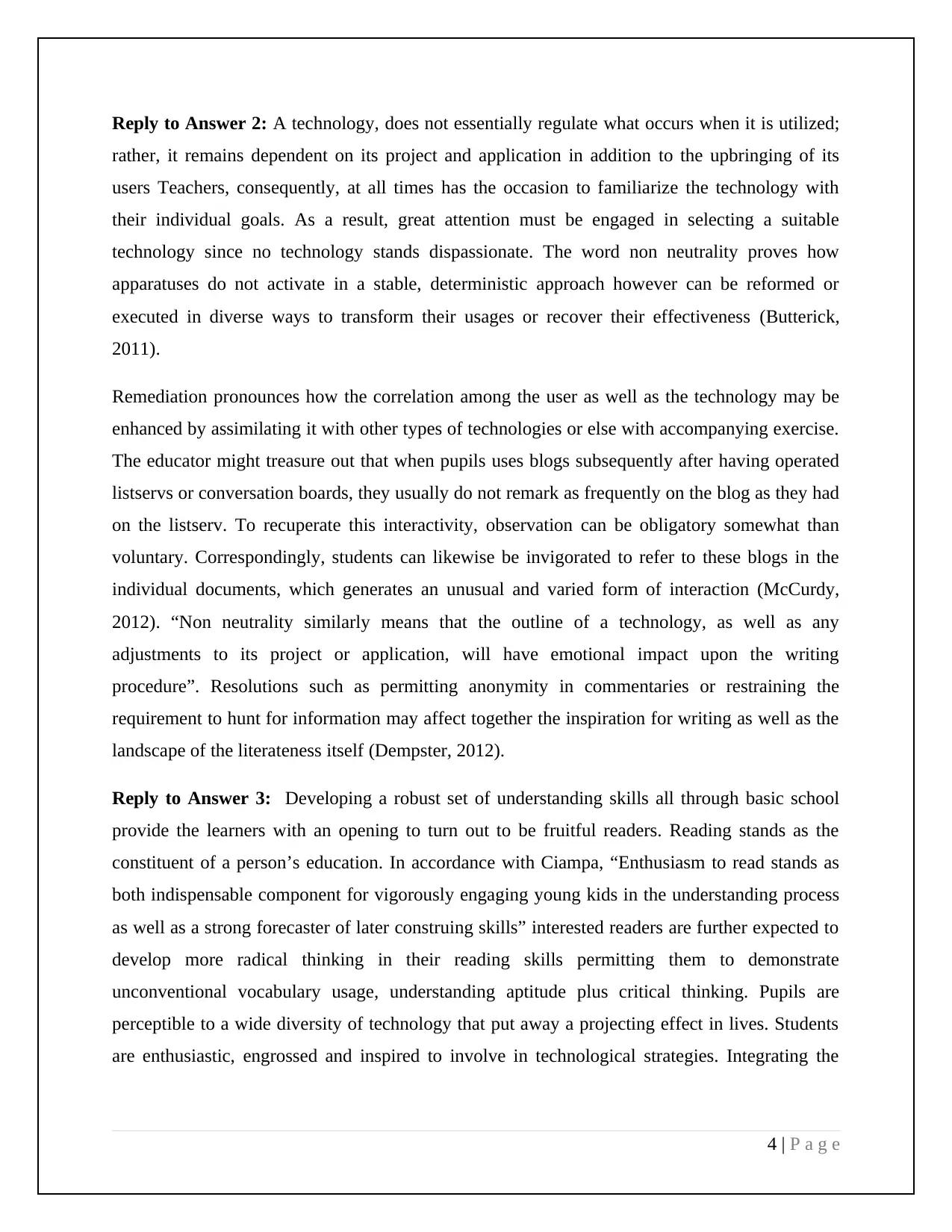
Reply to Answer 2: A technology, does not essentially regulate what occurs when it is utilized;
rather, it remains dependent on its project and application in addition to the upbringing of its
users Teachers, consequently, at all times has the occasion to familiarize the technology with
their individual goals. As a result, great attention must be engaged in selecting a suitable
technology since no technology stands dispassionate. The word non neutrality proves how
apparatuses do not activate in a stable, deterministic approach however can be reformed or
executed in diverse ways to transform their usages or recover their effectiveness (Butterick,
2011).
Remediation pronounces how the correlation among the user as well as the technology may be
enhanced by assimilating it with other types of technologies or else with accompanying exercise.
The educator might treasure out that when pupils uses blogs subsequently after having operated
listservs or conversation boards, they usually do not remark as frequently on the blog as they had
on the listserv. To recuperate this interactivity, observation can be obligatory somewhat than
voluntary. Correspondingly, students can likewise be invigorated to refer to these blogs in the
individual documents, which generates an unusual and varied form of interaction (McCurdy,
2012). “Non neutrality similarly means that the outline of a technology, as well as any
adjustments to its project or application, will have emotional impact upon the writing
procedure”. Resolutions such as permitting anonymity in commentaries or restraining the
requirement to hunt for information may affect together the inspiration for writing as well as the
landscape of the literateness itself (Dempster, 2012).
Reply to Answer 3: Developing a robust set of understanding skills all through basic school
provide the learners with an opening to turn out to be fruitful readers. Reading stands as the
constituent of a person’s education. In accordance with Ciampa, “Enthusiasm to read stands as
both indispensable component for vigorously engaging young kids in the understanding process
as well as a strong forecaster of later construing skills” interested readers are further expected to
develop more radical thinking in their reading skills permitting them to demonstrate
unconventional vocabulary usage, understanding aptitude plus critical thinking. Pupils are
perceptible to a wide diversity of technology that put away a projecting effect in lives. Students
are enthusiastic, engrossed and inspired to involve in technological strategies. Integrating the
4 | P a g e
rather, it remains dependent on its project and application in addition to the upbringing of its
users Teachers, consequently, at all times has the occasion to familiarize the technology with
their individual goals. As a result, great attention must be engaged in selecting a suitable
technology since no technology stands dispassionate. The word non neutrality proves how
apparatuses do not activate in a stable, deterministic approach however can be reformed or
executed in diverse ways to transform their usages or recover their effectiveness (Butterick,
2011).
Remediation pronounces how the correlation among the user as well as the technology may be
enhanced by assimilating it with other types of technologies or else with accompanying exercise.
The educator might treasure out that when pupils uses blogs subsequently after having operated
listservs or conversation boards, they usually do not remark as frequently on the blog as they had
on the listserv. To recuperate this interactivity, observation can be obligatory somewhat than
voluntary. Correspondingly, students can likewise be invigorated to refer to these blogs in the
individual documents, which generates an unusual and varied form of interaction (McCurdy,
2012). “Non neutrality similarly means that the outline of a technology, as well as any
adjustments to its project or application, will have emotional impact upon the writing
procedure”. Resolutions such as permitting anonymity in commentaries or restraining the
requirement to hunt for information may affect together the inspiration for writing as well as the
landscape of the literateness itself (Dempster, 2012).
Reply to Answer 3: Developing a robust set of understanding skills all through basic school
provide the learners with an opening to turn out to be fruitful readers. Reading stands as the
constituent of a person’s education. In accordance with Ciampa, “Enthusiasm to read stands as
both indispensable component for vigorously engaging young kids in the understanding process
as well as a strong forecaster of later construing skills” interested readers are further expected to
develop more radical thinking in their reading skills permitting them to demonstrate
unconventional vocabulary usage, understanding aptitude plus critical thinking. Pupils are
perceptible to a wide diversity of technology that put away a projecting effect in lives. Students
are enthusiastic, engrossed and inspired to involve in technological strategies. Integrating the
4 | P a g e
Paraphrase This Document
Need a fresh take? Get an instant paraphrase of this document with our AI Paraphraser
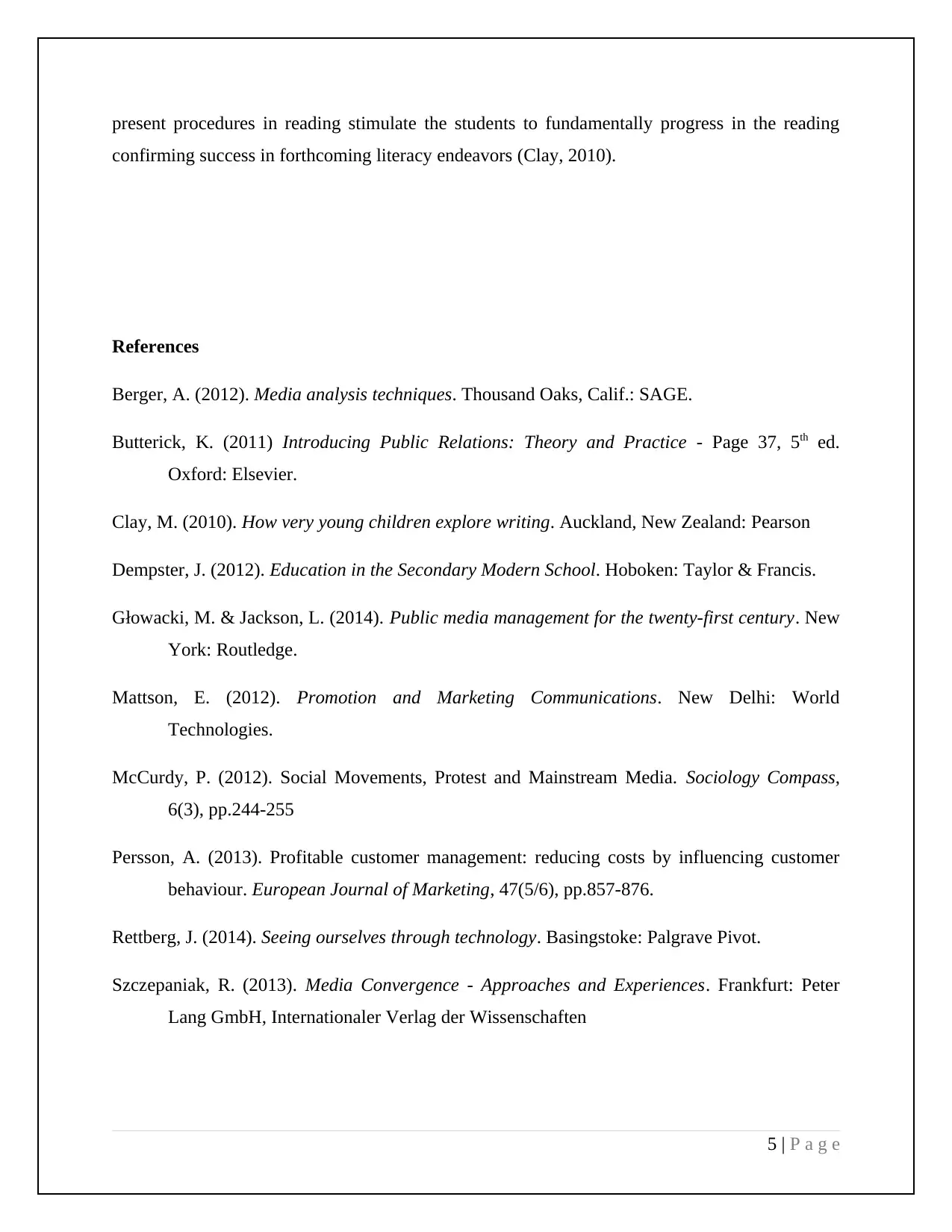
present procedures in reading stimulate the students to fundamentally progress in the reading
confirming success in forthcoming literacy endeavors (Clay, 2010).
References
Berger, A. (2012). Media analysis techniques. Thousand Oaks, Calif.: SAGE.
Butterick, K. (2011) Introducing Public Relations: Theory and Practice - Page 37, 5th ed.
Oxford: Elsevier.
Clay, M. (2010). How very young children explore writing. Auckland, New Zealand: Pearson
Dempster, J. (2012). Education in the Secondary Modern School. Hoboken: Taylor & Francis.
Głowacki, M. & Jackson, L. (2014). Public media management for the twenty-first century. New
York: Routledge.
Mattson, E. (2012). Promotion and Marketing Communications. New Delhi: World
Technologies.
McCurdy, P. (2012). Social Movements, Protest and Mainstream Media. Sociology Compass,
6(3), pp.244-255
Persson, A. (2013). Profitable customer management: reducing costs by influencing customer
behaviour. European Journal of Marketing, 47(5/6), pp.857-876.
Rettberg, J. (2014). Seeing ourselves through technology. Basingstoke: Palgrave Pivot.
Szczepaniak, R. (2013). Media Convergence - Approaches and Experiences. Frankfurt: Peter
Lang GmbH, Internationaler Verlag der Wissenschaften
5 | P a g e
confirming success in forthcoming literacy endeavors (Clay, 2010).
References
Berger, A. (2012). Media analysis techniques. Thousand Oaks, Calif.: SAGE.
Butterick, K. (2011) Introducing Public Relations: Theory and Practice - Page 37, 5th ed.
Oxford: Elsevier.
Clay, M. (2010). How very young children explore writing. Auckland, New Zealand: Pearson
Dempster, J. (2012). Education in the Secondary Modern School. Hoboken: Taylor & Francis.
Głowacki, M. & Jackson, L. (2014). Public media management for the twenty-first century. New
York: Routledge.
Mattson, E. (2012). Promotion and Marketing Communications. New Delhi: World
Technologies.
McCurdy, P. (2012). Social Movements, Protest and Mainstream Media. Sociology Compass,
6(3), pp.244-255
Persson, A. (2013). Profitable customer management: reducing costs by influencing customer
behaviour. European Journal of Marketing, 47(5/6), pp.857-876.
Rettberg, J. (2014). Seeing ourselves through technology. Basingstoke: Palgrave Pivot.
Szczepaniak, R. (2013). Media Convergence - Approaches and Experiences. Frankfurt: Peter
Lang GmbH, Internationaler Verlag der Wissenschaften
5 | P a g e
1 out of 5
Your All-in-One AI-Powered Toolkit for Academic Success.
+13062052269
info@desklib.com
Available 24*7 on WhatsApp / Email
![[object Object]](/_next/static/media/star-bottom.7253800d.svg)
Unlock your academic potential
Copyright © 2020–2025 A2Z Services. All Rights Reserved. Developed and managed by ZUCOL.


